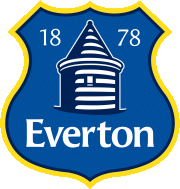
EVERTON F.C.
Founded: 1878
Also Known As:
ST. DOMINGO'S (1878)
EVERTON (1879-)

CLICK ON THE MAP TO
VIEW ENLARGED MAP
|
EVERTON F.C. (Football Club)
Included Info: Brief History, Club/Stadium Info, Team Jersey & Much More...
BRIEF HISTORY of EVERTON FOOTBALL CLUB
(reproduced from 'Wikipedia' pages)
Everton were founded as St Domingo's in 1878 so that people from the parish of St Domingo's Methodist Church
in Everton could play sport year round cricket was played in summer. The club was renamed Everton a year later
after the local area, as people outside the parish wished to participate. The club was a founding member of The
Football League in 188889, winning their first League Championship title in the 189091 season. Everton won the
FA Cup for the first time in 1906 and the League title again in 191415. The outbreak of the First World War in
1914 interrupted the football programme while Everton were champions, something that would again occur in 1939.
It was not until 1927 that Everton's first sustained period of success began. In 1925 the club signed Dixie Dean
from Tranmere Rovers who, in 192728, set the record for league goals in a single season with 60 goals in 39
league games, a record that still stands to this day. Dean helped Everton to achieve their third league title.
Everton were relegated to the Second Division two years later during internal turmoil at the club. However, the
club was promoted at the first attempt scoring a record number of goals in the second division. On return to the
top flight in 193132, Everton wasted no time in reaffirming their status and won a fourth League title at the
first opportunity. Everton also won their second FA Cup in 1933 with a 30 win against Manchester City in the
final. The era ended in 193839 with a fifth League title.
The outbreak of the Second World War again saw the suspension of League football, and when official competition
resumed in 1946 the Everton team had been split and paled in comparison to the pre-war team. Everton were relegated
for the second time in 195051 and did not return until 195354, finishing as runners-up in their third season in
the Second Division. The club have been a top-flight presence ever since. Everton's second successful era started
when Harry Catterick was made manager in 1961. In 196263, his second season in charge, Everton won the League title
and in 1966 the FA Cup followed with a 32 win over Sheffield Wednesday. Everton again reached the final in 1968,
but this time were unable to overcome West Bromwich Albion at Wembley.[13] Two seasons later in 196970, Everton
won the League championship, nine points clear of nearest rivals Leeds United. During this period, Everton were
the first English club to achieve five consecutive years in European competitionsseasons 196162 to 196667.
However, the success did not last; the team finished fourteenth, fifteenth, seventeenth and seventh in the
following seasons. Harry Catterick retired but his successors failed to win any silverware for the remainder
of the 1970s. Though the club mounted title challenges finishing fourth in 197475 under manager Billy Bingham,
and under manager Gordon Lee, third in 197778 and fourth the following season. Manager Gordon Lee was sacked in 1981.
Howard Kendall took over as manager and guided Everton to their most successful era. Domestically, Everton won the FA
Cup in 1984 and two league titles in 198485 and 198687 and the club's first and so far only European trophy securing
the European Cup Winners' Cup in the 1985 final. Having won both the league and Cup Winners Cup in 1985, Everton came
very close to winning a treble, but lost to Manchester United in the FA Cup final. The following season, 198586,
Everton were runners up to neighbours Liverpool in both the league and the FA Cup, but did recapture the league title
in 198687. After the Heysel Stadium disaster and the subsequent ban of all English clubs from continental football,
Everton lost the chance to compete for more European trophies. Everton were founder members of the Premier League in
1992, but struggled to find the right manager. When former Everton player Joe Royle took over in 1994 the club's form
started to improve; his first game in charge was a 20 victory over derby rivals Liverpool. Royle dragged Everton
clear of relegation, leading the club to the FA Cup for the fifth time in its history, defeating Manchester United
10 in the final. The cup triumph was also Everton's passport to the Cup Winners' Cuptheir first European campaign
in the post-Heysel era. Progress under Joe Royle continued in 199596 as they climbed to sixth place in the Premiership.
A fourth place finish in 200405, ensured Everton qualified for the Champions League qualifying round. The team failed
to make it through to the Champions League group stage and were then eliminated from the UEFA Cup. Everton qualified
for the 200708 and 200809 UEFA Cup competitions and they were runners-up in the 2009 FA Cup Final.
|
CLUB FACTS & INFORMATION
| Official Name
| --
| Everton F.C. |
| Club Nickname
| --
| The Toffees, The Blues |
| Year Founded
| --
| 1878 (139 years ago) |
| English County
| --
| Merseyside |
| Current Ground
| --
| Goodison Park |
| Ground Location
| --
| Liverpool, England |
| Club's Owner
| --
|
Farhad Moshiri (49.90%)
Bill Kenwright (12.16%)
Jon Woods (8.90%)
Other Shareholders (29.04%) |
| Club Chairman
| --
| Bill Kenwright |
| Current Manager
| --
| Ronald Koeman |
| Current League
| --
| Premier League |
| Last Season
| --
| Premier League, 7th place |
HOME COLORS

Royal Blue & White |
AWAY COLORS

White & Black |
|
| |
INTERESTING STADIUM FACTS & INFORMATION

GOODISON PARK
Goodison Road, Liverpool,
Merseyside, L4-4EL, England
OPENED: ......... August 24, 1892
SURFACE: ........ Desso GrassMaster
COST: .............. £3,000
CAPACITY: ...... 40,157
RECORD: ......... 78,299 (1948 vs Liverpool)
OWNER: ........... Everton Football Club Company, Ltd
OPERATOR: ..... Everton F.C.
FIELD SIZE: ..... 110 x 74 yards (100 x 68 meters)
|
|
|
HOME JERSEY
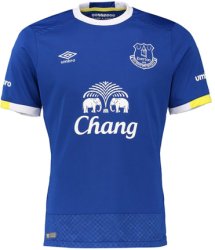 |
AWAY JERSEY
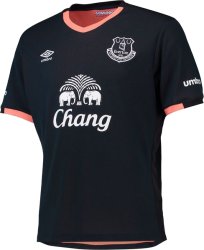 |
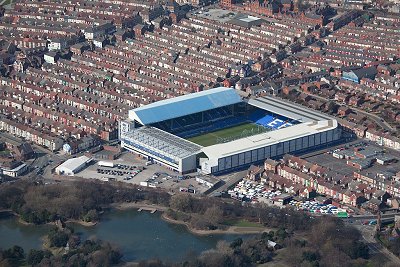
Click On Aerial Photo To View/Download Enlarged Image
|
Goodison Park (Everton) Seating Diagram
Click On Diagram Below To Enlarge View
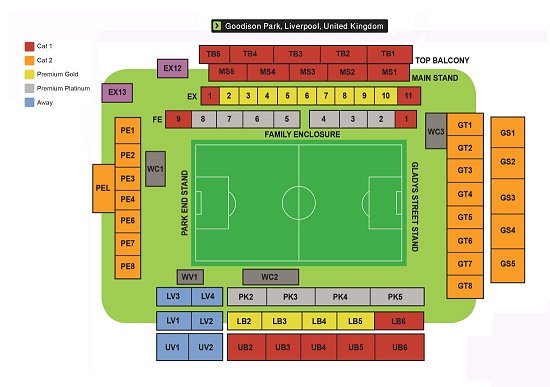
|



EVERTON STADIUM WALLPAPERS (Free Download)
Wallpaper Size below is 800x600: To Download Bigger Sizes, Click On Any Button Shown Above
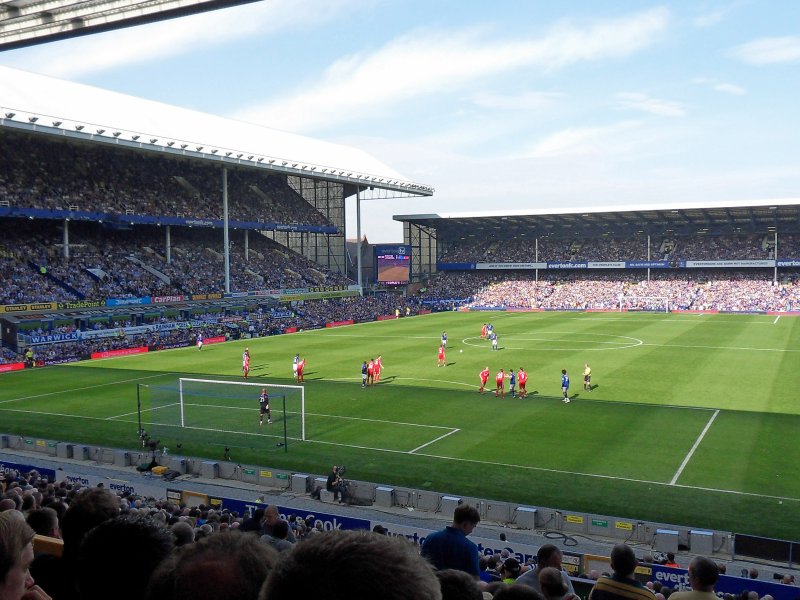
|
|

